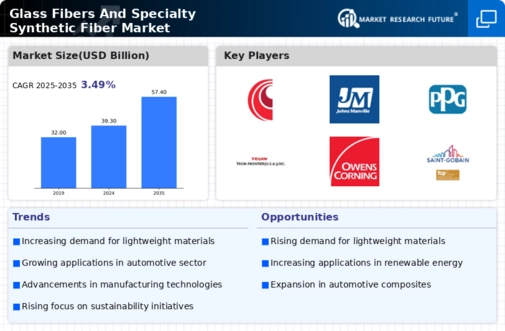Market Growth Projections
The Global Glass Fibers And Specialty Synthetic Fiber Market Industry is poised for substantial growth, with projections indicating a market value of 39.3 USD Billion in 2024 and an anticipated increase to 57.4 USD Billion by 2035. This growth trajectory suggests a compound annual growth rate (CAGR) of 3.49% from 2025 to 2035. The expansion is driven by various factors, including rising demand in construction, automotive, and renewable energy sectors. As industries increasingly adopt glass fibers for their lightweight and durable properties, the market is likely to witness significant advancements and innovations, positioning it favorably for future developments.
Expansion of Aerospace Applications
The aerospace industry increasingly relies on the Global Glass Fibers And Specialty Synthetic Fiber Market Industry for lightweight and high-strength materials. Glass fibers are utilized in aircraft components, contributing to enhanced fuel efficiency and performance. As air travel continues to grow, the demand for advanced composite materials is expected to rise, fostering innovation within the industry. The integration of glass fibers in aerospace applications not only improves structural integrity but also reduces overall weight, which is critical for fuel savings. This trend indicates a promising future for the market as it aligns with the aerospace sector's objectives of sustainability and efficiency.
Increased Focus on Renewable Energy
The Global Glass Fibers And Specialty Synthetic Fiber Market Industry benefits from the growing emphasis on renewable energy solutions. Glass fibers are essential in the production of wind turbine blades and solar panels, where their lightweight and durable properties enhance performance and longevity. As countries worldwide invest in renewable energy infrastructure, the demand for glass fibers is expected to rise. This trend aligns with global efforts to transition towards sustainable energy sources, potentially driving market growth at a CAGR of 3.49% from 2025 to 2035. The industry's role in supporting renewable energy initiatives highlights its importance in addressing environmental challenges.
Rising Demand in Construction Sector
The Global Glass Fibers And Specialty Synthetic Fiber Market Industry experiences a notable surge in demand driven by the construction sector. Glass fibers are increasingly utilized in reinforced concrete, roofing, and insulation materials, enhancing structural integrity and energy efficiency. In 2024, the market is projected to reach 39.3 USD Billion, reflecting the growing preference for lightweight and durable materials in construction. Furthermore, the trend towards sustainable building practices further propels the adoption of glass fibers, as they contribute to reduced carbon footprints. This shift indicates a robust growth trajectory for the industry, particularly as urbanization continues to expand globally.
Growing Automotive Industry Applications
The automotive sector significantly influences the Global Glass Fibers And Specialty Synthetic Fiber Market Industry, as manufacturers increasingly incorporate glass fibers into vehicle components. The lightweight nature of glass fibers contributes to improved fuel efficiency and reduced emissions, aligning with global sustainability goals. As the automotive industry evolves towards electric and hybrid vehicles, the demand for advanced composite materials, including glass fibers, is anticipated to rise. This shift is likely to propel the market, with projections indicating a growth to 57.4 USD Billion by 2035. The integration of glass fibers in automotive applications underscores the industry's adaptability and relevance in a changing landscape.
Technological Advancements in Fiber Production
Technological innovations play a crucial role in shaping the Global Glass Fibers And Specialty Synthetic Fiber Market Industry. Advanced manufacturing techniques, such as automated production lines and improved fiber spinning technologies, enhance the quality and efficiency of fiber production. These advancements not only reduce costs but also enable the development of specialized fibers tailored for specific applications, such as aerospace and automotive industries. As a result, the market is likely to witness increased investments in research and development, fostering innovation and expanding the range of applications for glass fibers. This trend is expected to contribute to the industry's growth as it adapts to evolving market demands.








